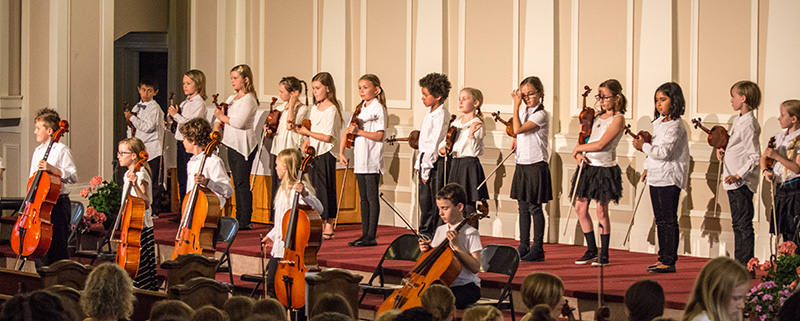Beginning in third grade, all City of Lakes Waldorf School students learn to play the cello, viola or violin through our String Ensemble Program. In anticipation of our annual Spring Ensemble Concert – coming up on Monday, April 29 at 6:30 pm – we asked String Ensemble Teacher Stasia Verdoljak to share a few interesting facts about our String Ensemble program.
Why are students asked to play a stringed instrument?
There are many positive qualities that can be deeply developed by playing a bowed stringed instrument. Patience is needed to practice and learn such a demanding type of instrument; skillsets are gained/synapses are formed – gross motor in the right or “bow hand” by sounding out rhythms and tonal qualities, and fine motor with the left or “instrument hand” by finding pitches and melodies; and creativity and deep listening is employed as there are an infinite number of pitches from which to choose on a non-fretted instrument.
Additional benefits include the development of awareness and intuition within each student and for the group, and feeling the music without having to necessarily name the exact emotion.
What’s going on in the classroom these days?
Rehearsals for the spring concert, of course (Monday, April 29 at 6:30 pm at the church)! During “tuning time” while students unpack, tune, and make sure their instruments are ready to be played and music stands have the correct sheet music displayed, you will find students practicing lines to introduce their ensembles; practicing the tricky rhythms at measures 39-46; encouraging each other when someone gets frustrated with the process; wailing away at their favorite melody, even though they know it already (but they love playing it more than “that other part that’s so difficult!”); helping each other mark in the sheet music to remember where there’s an F#; etc.
Best of all, after tuning time when we all work together, there is often a big, spontaneous cheer when we get through the piece tunefully and with a critical mass for the first time! Hip, hip, hooray! (“Now that we stayed together and had most of the correct notes, let’s practice whether our bows are going the same way…” and the process continues.)
What are three things that make a string ensemble class tick?
Enthusiasm for their instruments, feeling something toward the music, and patience for themselves, each other, and the learning process as they listen, learn and play. And the list goes on!
Why have a home practice routine in middle school when students already know “how to play” and can play in class while they’re at school?
There are both individual and communal aspects to this journey – having the persistence to saw away on instruments at home and practice their part individually as well as continue to gain skills with private lessons leads to being able to come together at school to play something that is often exponentially more satisfying with others. When everyone puts in the work outside of class through, yes, the banality of practice, lessons, and sometimes desperately trying to figure out how to carpool (with two cellos!), the experience of music-making with their classmates is much more beautiful, progressive and satisfying for everyone involved! Ideally, playing with the group in turn energizes their individual practice, and so-on and so-forth.
See you on April 29!


